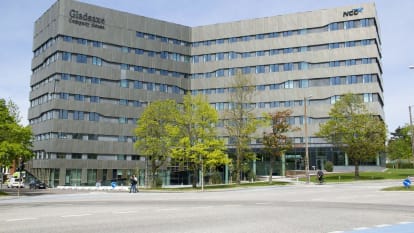Gladsaxe Company House
Denmark’s first office building with DGNB Platinum certification.
Gladsaxe Company House is a multi-user building that combines sustainable materials, flexible working areas and technical solutions to create a healthy environment – both inside and out. The building was the first in Denmark to be awarded DGNB Platinum certification thanks to its holistic approach to sustainability and its practical showcasing of the potential future workplace.
The entrance, with recycled wood from the stands at Lyngby Stadium and vertical living walls, typifies the atmosphere, setting the green agenda from the moment you walk through the door.
DGNB Platinum is the ultimate in green, sustainable certification. Gladsaxe Company House won the award for its high level of sustainability compliance: with environmental, economic and social requirements as well as those relating to functionality, process and technology. It is not only energy consumption and materials that are analyzed, but also indoor comfort and climate, artistic environment and spatial flexibility. As part of the certification, the building also features specially designed artwork produced by a local artist for the pleasure of both employees and visitors.
Sustainable materials
Sustainable materials play an important role in the building. The building materials and components were selected so that they can be taken apart and recycled after demolition or deconstruction.
In Gladsaxe Company House, mechanical joining of parts has been used, with screws replacing glue and bolts replacing welding. This means the building can be taken apart and the individual parts recycled. In the longer term, there is a plan for future adaptation, demolition and disassembly, with the most important characteristics for all components specified, including any health risks that may be associated with these initiatives.
Overall, 90 percent of the wood that has been used is FSC certified. The remaining 10 percent is regenerated timber and recycling from other building sites. Recycling is an important process in the life cycle of the building. Surplus material from the boarding, advertising signs and panels from the building site has been recycled rather than incinerated. As an example, a large part of the waste material from the building process was reused in pressed chipboard.
Energy
The Y shape of the building enables all desks to be situated in the immediate vicinity of the façade, minimizing the need for artificial light. 12 percent of the building's energy requirement is covered by 208 solar roof panels occupying an area of 311 m2. All lifts have been fitted with converters that recycle the surplus energy created when breaking.
Water
In order to satisfy the municipal water discharge rules, Gladsaxe Company House is obliged to collect as much rainwater as possible on site before discharging to the public sewer. Two thirds of the rainwater that falls on the site around Gladsaxe Company House is absorbed by the outdoor vegetation and redirected to absorption beds and local reservoirs.
Health & Safety
In Gladsaxe Company House, we have reduced the use of environmentally harmful materials. The building has a very low content of formaldehyde. Where glue, paint and binders have been used, these are certified products that do not contain VOCs (volatile organic compounds).
The Company House® concept is a well-defined concept for a multi-user building where the practical, economic and legal factors have been documented and tested in practice. Gladsaxe Company House combines the best in sustainability with the best in working environment and is proof that it is possible to achieve the highest standard for sustainability in respect of energy consumption, resource usage and social aspects at an affordable price.
Gladsaxe Company House goes beyond the standards that define sustainable building expertise in Scandinavia. As a result, this building is a milestone in green building for the Nordic region.
